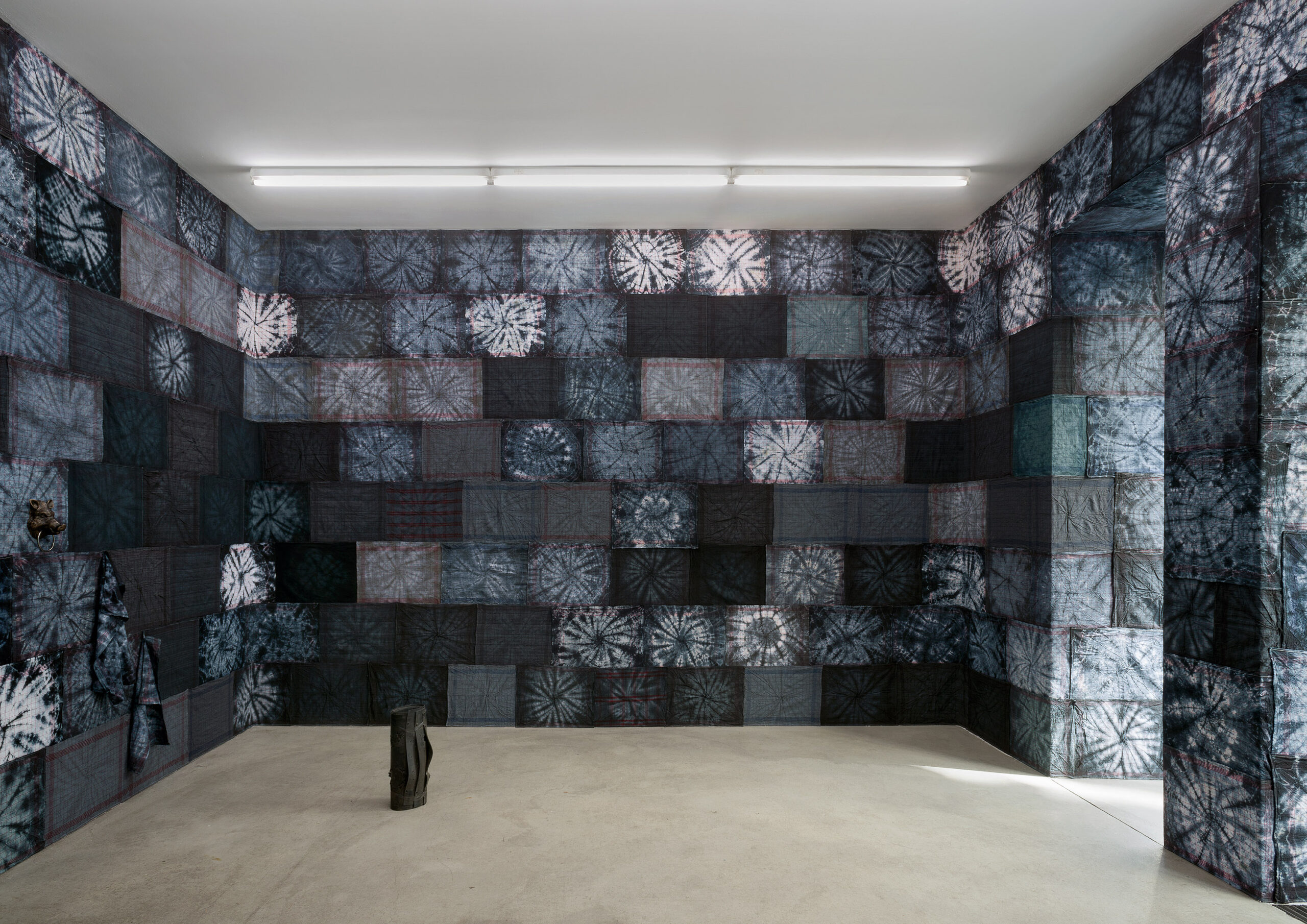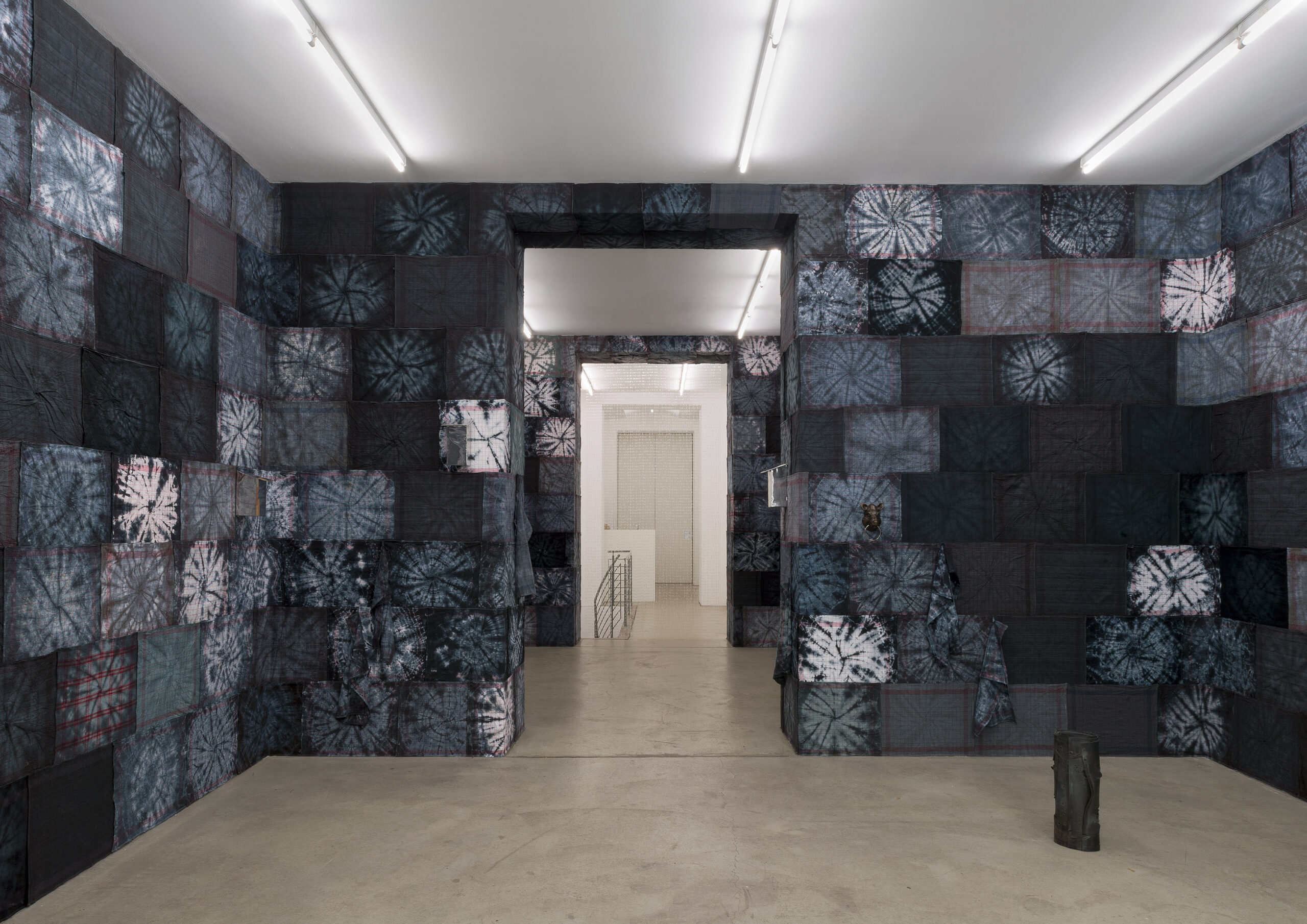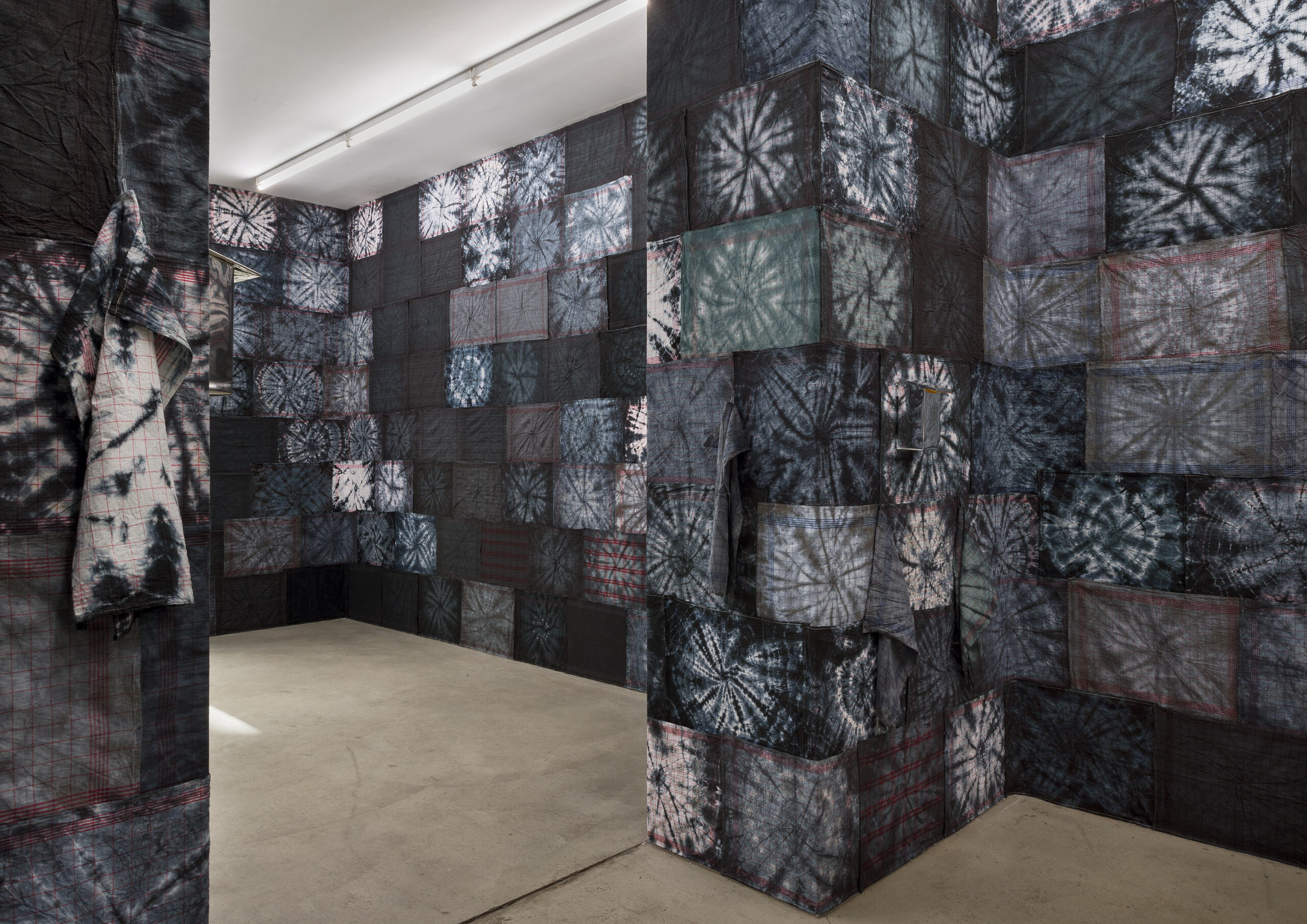
Into this house we’re born
Into this world we’re thrown
Like a dog without a bone
An actor out on loan
Riders on the storm
The Doors, 1971
Das karierte Geschirrtuch hängt ordentlich gefaltet in der Küche. Die Vorhänge sind zugezogen. Es ist nach sechs. Die Nachrichtensendung beginnt. Ein Sturm zieht auf.
Mit seiner Einzelausstellung „all clear“ begibt sich Max Schaffer mit gewohnt reflektiertem, und doch ein wenig schelmischem Selbstverständnis auf unsicheres Terrain. Eine raumgreifende Installation aus neuen Textilarbeiten stellt unvermittelt klar, dass eine domestizierte Idylle sich im Umbruch befindet. Klassische Geschirrhandtücher hat der Künstler, dessen Strategie sowohl konzeptuell als auch formal im Spannungsverhältnis von Alltagskultur und kulturellem Diskurs in einer vielschichtigen Verkettung aus Aneignungen und Referenzen besteht, diesmal zum Grundmaterial seiner Ausstellung erklärt; nicht etwa als Readymade, sondern als Gegenstand eines Übergriffs. In Batiktechnik mit schwarzer Farbe gefärbt bringen die mit biederer Häuslichkeit assoziierten Textilien in aller Direktheit zum Ausdruck was als subtiler Unterton das ganze Ausstellungskonzept prägt: Etwas ist hier aus den Fugen geraten, das Unkontrollierbare, Unbekannte, Andere hat sich über die gute Ordnung ergossen und lädt nun zur unausweichlichen Konfrontation mit einem nicht näher benannten, in jeder Hinsicht aber nicht mehr rückgängig zu machenden Geschehnis ein.
„Let’s show Irma that we shoot first” lautete ein Facebook-Eintrag, als 2017 Hurricane Irma über den amerikanischen Bundesstaat Florida hinwegfegte. 54.000 Menschen hatten sich für das Event „interessiert“. „Don’t shoot at the storm“ konterte die Polizei schließlich, mit der Begründung (sowie einer begleitenden Infografik), die Kugeln würden zurückkommen, ihre Richtungsänderung sei unkalkulierbar, die Folgen nicht absehbar. Ein Boomerang Effekt.
Die domestizierte Form bietet keine Zuflucht vor den Entwicklungen der Welt. Das Raster kann die Farbe nicht bremsen, eine Form, die nun ihrer eigenen Systematik folgt: Zirkular, wie ein Sturm, der unaufhaltsam seine Kreise zieht.
So konform das Ausgangsmaterial – das klassische Geschirrtuch in Variation – zu sein scheint, so unterschiedlich fallen die einzelnen Endprodukte aus: Das Unvorhersehbare der als einer „alternativen“ Kulturströmung zugeschriebenen Technnik des „Tie Dye“ tritt auch bei gleicher Farbe, gleicher Schnürung und gleichlanger Einwirkzeit zu Tage. Eine Unterwerfung scheint unmöglich.
Assoziationen zu den emanzipatorischen Strategien der Counterculture oder der gegenwärtig vielerorts als Angriff auf die konservative Wertegesellschaft aufgefasste Offenheit gegenüber neuen und alternativen Lebensmodellen lässt die Arbeit ebenso zu wie ein kritisches Nachhallen der jüngsten gesellschaftspolitischen Entwicklungen in Europa und den USA.
„Die Schoten dicht machen“ affirmieren kubische Körper aus unterschiedlichen Materialien, die formal an Nistkästen erinnern, doch Ein- und Ausgang haben sie keinen. Hermetisch verschlossen trotzen sie dem Wirbel, wirkliche Zuflucht bieten sie aber weder im Drinnen noch vor dem Draußen.
Doch das Verschließen erscheint ebensowenig sinnvoll wie der Frontalangriff, der Aufstand entsteht im Inneren: Das Private ist immer politisch. Längst hat die vermeintliche Unterwanderung gesellschaftlicher Normen sich bereits mehrfach vollzogen, eine Aneignung, vielmehr noch: eine Vereinnahmung als Entgegnung einer kulturellen Hegemonie, die ihrerseits längst aus dem Ruder gelaufen ist. Max Schaffer stellt das Unerträgliche der sogenannten Heimatkultur in einem subversiven Akt zur Disposition und hat die Wände damit tapeziert – eine eindringliche immersive Vergegenwärtigung eines andauernden Wetterumschwungs. “all clear”, so der Künstler, ist eine vermeintliche Entwarnung, wir dürfen noch lange nicht aufatmen.
– Marlies Wirth
Into this house we’re born
Into this world we’re thrown
Like a dog without a bone
An actor out on loan
Riders on the storm
The Doors, 1971
The checkered dish-towel hangs neatly folded in the kitchen. The curtains are drawn. It is after six o’clock. The newscast is about to start. A storm is looming.
With his solo exhibition “all clear” Max Schaffer ventures into uncertain terrain, all cleverly reflected but with a slightly cheeky implicitness. A space-capturing installation of new textile works illustrates the theme that ‘domestic bliss is undergoing radical change’. This time the artist, whose style explores conceptually and formally the charged relationship between everyday culture and cultural discourse in a multi-layered interconnection of appropriations and references, uses conventional dish-towels as the basic material of his exhibition – not as a readymade, but as an item of encroachment. Tinted in batik technique with black dye, the textiles usually associated with conservative domesticity seem to mirror the characteristics of the exhibition concept with a subtle undertone: something is out of whack here, the uncontrollable, the unknown, the other has upset the order of things and is now asking for an unavoidable confrontation with something that remains undisclosed, an event that can no longer be reversed.
“Let’s show Irma that we shoot first” was a Facebook post that was made when Hurricane Irma swept over the US state of Florida in 2017. More than fifty-four thousand people were “interested” in the event. “Don’t shoot at the storm” countered the police finally, explaining (accompanied by a comprehensive infographic) that the bullets would come back, their change of direction is incalculable and consequences are unpredictable – a boomerang effect.
Domesticity offers no refuge from global progress. The grid can’t hold back the color from following its own system: a circular one like a cyclone that inexorably draws its own circles.
As conforming as the initial material appears to be, as different is the end result after batik dying classic dishcloths. Despite the same color, same lacing and same application time, the “tie dying” technique, once attributed to “alternative” culture, is unpredictable. Submission seems impossible.
The work allows associations with the emancipatory strategies of the counter-culture and the openness of new and alternative models of life that are currently being perceived as an attack on the conservative values of society, a somewhat critical resonance of the latest socio-political developments in Europe and the United States.
“Die Schoten dicht machen” (batton down the hatches) affirm wall-mounted cubes made of various materials which are formally reminiscent of nest boxes, but have no entrance or exit. Hermetically sealed, they may defy the vortex but they don’t offer real refuge, neither inside nor from the outside.
A lock-down appears just as useless as a frontal attack, the uprising starts from within: the personal is always political. The alleged infiltration of social norms has already occurred multiple times by now, an appropriation, no: an absorption in response to a cultural hegemony, which in itself spun out of control long ago. Max Schaffer questions the unbearable of “native culture” in a subversive act and has papered the walls with it, a vivid, immersive visualisation of constantly changing weather. According to the artist, the declaration “all clear” is but a reputed all-clear signal: it will be a long time until we can breathe a sigh of relief.
– Marlies Wirth




